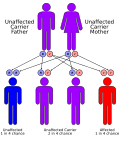Arterial tortuosity syndrome
| Arterial Tortuosity Syndrome | |
|---|---|
| Synonyms | N/A |
| Pronounce | N/A |
| Specialty | N/A |
| Symptoms | Arterial tortuosity, joint hypermobility, skin laxity, inguinal hernia |
| Complications | Aneurysm, stenosis |
| Onset | Congenital |
| Duration | Lifelong |
| Types | N/A |
| Causes | Genetic mutation in the SLC2A10 gene |
| Risks | Family history |
| Diagnosis | Genetic testing, clinical evaluation |
| Differential diagnosis | N/A |
| Prevention | N/A |
| Treatment | Surgical intervention, symptomatic management |
| Medication | N/A |
| Prognosis | N/A |
| Frequency | Rare |
| Deaths | N/A |
Arterial Tortuosity Syndrome (ATS) is a rare genetic disorder characterized by the elongation and tortuosity of the arteries. This condition is associated with mutations in the SLC2A10 gene, which encodes the GLUT10 protein, a member of the glucose transporter family.
Signs and Symptoms[edit]
Individuals with Arterial Tortuosity Syndrome often present with a variety of symptoms, including:
Complications can include the development of aneurysms and stenosis in affected arteries, which can lead to serious cardiovascular issues.
Genetics[edit]
Arterial Tortuosity Syndrome is inherited in an autosomal recessive manner. This means that an individual must inherit two copies of the mutated SLC2A10 gene, one from each parent, to be affected by the condition. Carriers, who have only one copy of the mutation, typically do not show symptoms.
Diagnosis[edit]
Diagnosis of ATS is based on clinical evaluation and confirmed through genetic testing. The presence of characteristic symptoms, along with a family history of the condition, can prompt genetic testing for mutations in the SLC2A10 gene.
Treatment[edit]
There is no cure for Arterial Tortuosity Syndrome, but treatment focuses on managing symptoms and preventing complications. This may include:
- Surgical intervention to correct arterial abnormalities
- Symptomatic management for joint and skin issues
See Also[edit]
References[edit]
<references group="" responsive="1"></references>
External Links[edit]
- [Genetic and Rare Diseases Information Center - Arterial Tortuosity Syndrome](https://rarediseases.info.nih.gov/diseases/107/arterial-tortuosity-syndrome)
- [OMIM Entry - #208050 - ARTERIAL TORTUOSITY SYNDROME](https://www.omim.org/entry/208050)
Arterial tortuosity syndrome[edit]
-
Arterial tortuosity syndrome
-
Arterial tortuosity syndrome
-
Arterial tortuosity syndrome
Ad. Transform your life with W8MD's Budget GLP-1 injections from $75


W8MD offers a medical weight loss program to lose weight in Philadelphia. Our physician-supervised medical weight loss provides:
- Weight loss injections in NYC (generic and brand names):
- Zepbound / Mounjaro, Wegovy / Ozempic, Saxenda
- Most insurances accepted or discounted self-pay rates. We will obtain insurance prior authorizations if needed.
- Generic GLP1 weight loss injections from $75 for the starting dose.
- Also offer prescription weight loss medications including Phentermine, Qsymia, Diethylpropion, Contrave etc.
NYC weight loss doctor appointmentsNYC weight loss doctor appointments
Start your NYC weight loss journey today at our NYC medical weight loss and Philadelphia medical weight loss clinics.
- Call 718-946-5500 to lose weight in NYC or for medical weight loss in Philadelphia 215-676-2334.
- Tags:NYC medical weight loss, Philadelphia lose weight Zepbound NYC, Budget GLP1 weight loss injections, Wegovy Philadelphia, Wegovy NYC, Philadelphia medical weight loss, Brookly weight loss and Wegovy NYC
|
WikiMD's Wellness Encyclopedia |
| Let Food Be Thy Medicine Medicine Thy Food - Hippocrates |
Medical Disclaimer: WikiMD is not a substitute for professional medical advice. The information on WikiMD is provided as an information resource only, may be incorrect, outdated or misleading, and is not to be used or relied on for any diagnostic or treatment purposes. Please consult your health care provider before making any healthcare decisions or for guidance about a specific medical condition. WikiMD expressly disclaims responsibility, and shall have no liability, for any damages, loss, injury, or liability whatsoever suffered as a result of your reliance on the information contained in this site. By visiting this site you agree to the foregoing terms and conditions, which may from time to time be changed or supplemented by WikiMD. If you do not agree to the foregoing terms and conditions, you should not enter or use this site. See full disclaimer.
Credits:Most images are courtesy of Wikimedia commons, and templates, categories Wikipedia, licensed under CC BY SA or similar.
Translate this page: - East Asian
中文,
日本,
한국어,
South Asian
हिन्दी,
தமிழ்,
తెలుగు,
Urdu,
ಕನ್ನಡ,
Southeast Asian
Indonesian,
Vietnamese,
Thai,
မြန်မာဘာသာ,
বাংলা
European
español,
Deutsch,
français,
Greek,
português do Brasil,
polski,
română,
русский,
Nederlands,
norsk,
svenska,
suomi,
Italian
Middle Eastern & African
عربى,
Turkish,
Persian,
Hebrew,
Afrikaans,
isiZulu,
Kiswahili,
Other
Bulgarian,
Hungarian,
Czech,
Swedish,
മലയാളം,
मराठी,
ਪੰਜਾਬੀ,
ગુજરાતી,
Portuguese,
Ukrainian


